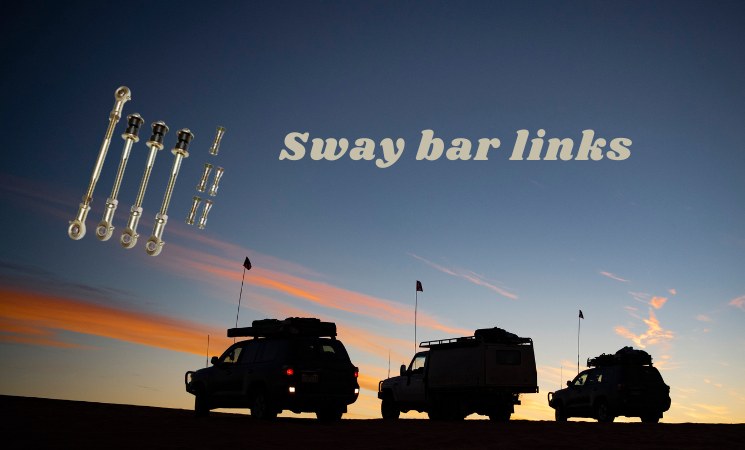If you’ve ever taken your 4WD through a rough trail or around a sharp turn, you’ve probably felt your vehicle lean to one side. That’s body roll. It’s a natural part of driving, but too much of it can make your ride unstable and unpredictable – this is where sway bar links come in.
Sway bar links might not be the first thing you think about when upgrading your 4WD, but they play a huge role in handling, stability, and safety. Whether you’re navigating tight corners or tackling off-road terrain, having the right sway bar links can make a noticeable difference.
So, what exactly do they do, and why should you care? Let’s break it down.
What Is a Sway Bar Link?
Think of the sway bar, also known as an anti-roll bar, as a bridge between the left and right sides of your suspension. It’s designed to reduce body roll when cornering or driving on uneven terrain.
The sway bar link is the small but crucial piece that connects the sway bar to the suspension components. Without a properly functioning sway bar link, the sway bar can’t do its job effectively, leading to unstable handling, excessive tilting, and reduced control.
In simple terms:
- Good sway bar links mean better stability.
- Worn-out links lead to a rougher, less predictable ride.
Signs Your Sway Bar Links Need Replacing
Sway bar links wear out over time, and ignoring them can lead to poor handling and even safety issues. Here’s how to tell if yours need attention:
- Clunking or rattling noises, especially when driving over bumps or making sharp turns.
- Excessive body roll, where your vehicle leans more than usual in corners.
- Loose or unresponsive steering, making the car feel unstable.
- Uneven tire wear, which suggests an imbalance in the suspension.
If you notice any of these issues, it’s worth getting your sway bar links inspected and replaced if necessary.
Why Upgrade Your Sway Bar Links?
Most stock sway bar links are fine for everyday driving, but they’re not built for the demands of off-roading or high-performance handling. If you take your 4WD off-road frequently, haul heavy loads, or just want better stability, upgrading your sway bar links is a smart move.
Benefits of upgraded sway bar links:
- Stronger materials such as reinforced steel or aluminum, making them more durable.
- Better articulation for off-road driving where suspension flex matters.
- Reduced noise and play, preventing clunking sounds and loose steering.
- More responsive handling to keep the vehicle level, reducing excessive weight shifts.
If you’ve lifted your 4WD, adjustable sway bar links are necessary to keep the suspension geometry in check.
Stock vs. Heavy-Duty Sway Bar Links: Which One Is Right for You?
Your choice depends on how you use your vehicle.
- Stock Sway Bar Links – Best for daily driving, city roads, and light off-roading. If you rarely push your 4WD to its limits, stock links are sufficient.
- Heavy-Duty or Aftermarket Links – Ideal for off-roaders, lifted trucks, and performance-focused drivers. These links withstand more stress, offer better articulation, and improve handling on rough terrain.
If you drive on dirt trails, rocky paths, or uneven terrain, investing in heavy-duty sway bar links can significantly reduce stress on your suspension.
Installing and Maintaining Sway Bar Links
Replacing sway bar links is a relatively simple job, but proper installation is key. Here’s what you need to know:
- DIY or Mechanic? If you’re comfortable with basic tools, you can replace sway bar links at home. However, if you have a lifted suspension or an aftermarket setup, a professional installation ensures proper torque and fitment.
- Regular Inspections Check for visible wear, cracks, or looseness during routine maintenance.
- Lubrication Matters Some aftermarket sway bar links have grease fittings that require occasional lubrication to prevent premature wear.
- How Long Do They Last? On average, sway bar links last between 50,000 and 100,000 miles, but off-road use can shorten their lifespan.
Are Sway Bar Links Always Necessary for Off-Roading?
Here’s something most 4WD owners don’t realize: disconnecting your sway bar links before heading off-road can actually improve suspension flex.
Some off-roaders use quick-disconnect sway bar links, which allow the suspension to move freely over uneven terrain, improving articulation. However, on-road driving without a sway bar link is dangerous, so always reconnect before hitting pavement.
Why You Should Care About Sway Bar Links
Sway bar links might not be the most exciting part of your 4WD’s suspension, but they’re one of the most important for stability and control.
If you’re experiencing loose steering, excessive body roll, or strange noises from your suspension, don’t ignore it – your sway bar links might be worn out.
For daily drivers, replacing old links can restore smooth handling.
For off-roaders, upgrading can mean better stability, durability, and performance.
And for those who push their 4WD to the limit?
A well-tuned suspension can be the difference between a controlled ride and a dangerous rollover.
So next time you hit the road – or the trail – know that those small but mighty sway bar links are working hard to keep your 4WD steady.
What’s Your Experience?
Have you upgraded your sway bar links? Noticed a difference in handling? Share your experience in the comments!














Leave a Reply